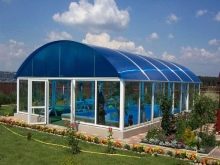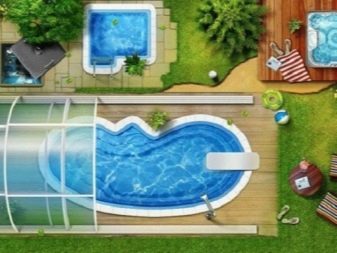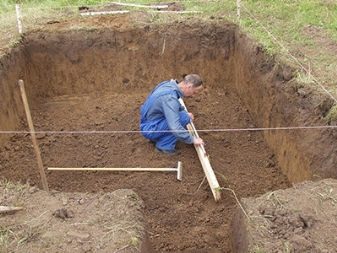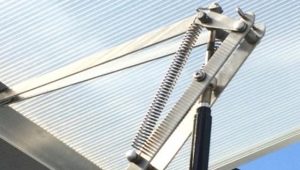How to organize a pool in the greenhouse?

The pool in the greenhouse is a unique solution to the problem of a short bathing season, which is especially important for the middle belt areas. Summer in such latitudes does not last long and does not allow you to fully enjoy swimming in your own pool. An excellent way out of the situation will be the construction of a protective pavilion made of the same materials as the greenhouse facilities.
The device and the feasibility of construction
The pool in the greenhouse is a structure of translucent materials with a bowl located inside. The construction can have both an open design and be equipped with doors and windows. In the first case, the shelter acts as a canopy, under which, besides a bowl of water, a rest area can be placed.
Closed structures are equipped with full-fledged doors and involve the installation of heating equipment. In this case, the operation of the pool can be all-season in nature, which is a very convenient option for owners of private cottages in conditions of moderately cold winters.
If we talk about the feasibility of the construction of such a structure, it is justified by several reasons.
- Protecting water from falling foliage, mechanical debris and insects due to the presence of walls and roofs, while there is a technical possibility to install windows and air vents with mosquito nets, which solves the problem of ventilation of greenhouses.
- Swimming in the pool is possible under any climatic conditions: in the summer months air and water are heated due to the concentration of natural solar heat and the greenhouse effect, and during the cold period heaters are installed in the room.
- Due to the presence of the roof, swimmers are effectively protected from the harmful effects of direct ultraviolet rays. This is especially convenient for families with small children and elderly people, for whom prolonged exposure to the sun is contraindicated.
- Tangible reduction in the cost of cleaning and maintenance of the bowl.
Advantages and disadvantages
A large number of positive reviews about the equipment of the pools in the greenhouse due to a number of advantages of such facilities.
- Wide consumer availability of the necessary materials and the possibility of self-construction. In addition, as a protective structure can be used ready greenhouse, the assembly of which is carried out according to the attached instructions and, as a rule, does not cause difficulties even for beginners.
- Neat and aesthetic appearance. The pool fits well into the landscape of the plot and harmonizes with these greenhouses and greenhouses. Most often they are made of the same materials, so they do not cause dissonance of perception.
- Significant reduction in the cost of heating water. In spring, summer and autumn, the water is heated naturally and does not require additional heating.
- The high resistance of the structure to the aggressive conditions of external factors is due to the increased strength of greenhouse structures, designed for increased wind loads and resistant to negative temperatures.
- Protection of water against the development of pathogenic microorganisms is due to the limited access to water for insects and worms, as well as the impossibility of penetration of plant pollen and organic remains.
- A significant reduction in the evaporation of water due to the closed room, and maintaining a comfortable humidity regime - the possibility of regular ventilation.
- Low cost of consumables.
The disadvantages of the structures include a rather laborious construction process and an increase in construction costs in comparison with outdoor pools.
Species
Shelters pools can be made in several versions. The most budget is a canopy, which covers the bowl with only one or two sides. The canopies also include arched structures that do not have side walls, and pitched roofs. The advantage of such structures is the simplicity of their manufacture and the absence of the need to install doors, windows and sliding systems.
In addition, the shelter can significantly exceed the size of the bowl in size, which makes it possible to place deck chairs, tables for drinks or hammocks near the water.The disadvantage of sheds and arches is the lack of side walls and all the inconveniences associated with it, including the poor heating of water and the ingress of mechanical debris into the pond.
Closer pavilions, presented both in the form of traditional greenhouses and made according to an individual design project, are more convenient and practical. Such structures include dome-shaped pavilions, installed above the round pools. The advantage of the structures is their unusual appearance, thanks to which the structure can become a central element of landscape design. The disadvantages include difficulties in the construction, which consist in the need to cut sheet material into segments.
An interesting option is the asymmetrical pavilion. The structure is represented by a semi-arch and is bounded on one side by a vertical wall. The advantage of this structure is quite simple installation and the ability to place inside the recreation area.
The disadvantages include the overall volume of the structure and the impossibility of installation in small areas.
Depending on the height of the structure, they are full-sized, allowing them to be in full growth, and low, having a height of no more than 50 cm. Low options also perform the function of a night or seasonal shelter.The roof of such greenhouses can have both stationary and sliding telescopic execution. The latter is considered the most convenient and allows you to open the roof at the request of swimmers, for example, in the absence of the sun or too high a temperature inside the greenhouse.
The bowls of greenhouses are also varied: In addition to the classic square options, there are often round, rectangular, combined and non-standard figured forms. In terms of location relative to the ground level, bowls are deepened and superficial. The first can be made of concrete and are the most durable, they are dug to any depth. The latter usually have a skeleton and canvas performance and are rarely deeper than one and a half meters.
Installation Tips
The first stage of building a pool in a greenhouse is the choice of location. The main requirement should be the absence of spreading trees that can create long-term shading.
An equally important factor is the ground. The best option would be clay and heavy soils, which act as natural waterproofing and do not allow groundwater to damage the base of the bowl.After the place is chosen, you need to decide on the shape of the structure. It should be borne in mind that non-standard figured bowls look very impressive, but the filtering system in them requires a qualified calculation. This is due to the uneven flow, so that the replacement of water and reagents should be made much more often than in containers with traditional forms.
The second step should be the choice of cleaning equipment. For small home pools, two types of filtration systems are usually used: skimmer and overflow.
In the first case, the water is fed into the filters using a skimmer, and then re-enters the pool. When using an overflow system, water constantly circulates from the main tank to the storage reservoir, in which it is cleaned, and again enters the main bowl. Water intake is carried out continuously and is made using gratings located at the edges of the pool. This cleaning method is much more efficient than the previous one, but it requires considerable investments and is difficult to maintain.
The next stage is the construction of the bowl.The simplest way is to arrange a container of polystyrene foam blocks. In addition to the fact that the material is light and of high strength, it quickly nourishes the air, is well ventilated and has high thermal insulation properties - this will allow the water to stay warm even at night.
For the construction of the bowl fit blocks of size XXL. Each block has deep grooves, with which you can fasten them with reinforcement. The blocks are easily cut using a regular hacksaw, which allows you to precisely fit all the elements to each other. In the process of forming the bowl in the blocks it is necessary to make holes for the drain pipes and the filtration system. All pipes and filters are insulated with foam.
After the bowl is formed, it is necessary to dilute the concrete solution and pour blocks into it, paying special attention to interblock joints. Then the bowl is left for several days to completely dry the concrete, then check for the absence of cracks. In the event of their appearance, the gap is drilled around the edges and processed with putty. After the composition has dried, the crack is filled with freshly prepared concrete solution and left to completehardening. Then the bowl is covered with waterproof film material or decorated with ceramic tiles.
The final stage will be the construction of the pavilion. The most economical option is the construction of shaped pipes and polycarbonate. The construction is going on the principle of greenhouses and can have its own foundation, and rely on the foundation of the bowl. The foundation should have a depth of at least 50 cm and be made using the reinforcement of the concrete solution. The skeleton on the foundation is fixed with the help of bolts, and the fixation of the arcs and stiffeners is carried out with the help of special fastening elements.
After assembly, the frame is coated with an anti-corrosion compound and painted in the desired color. Then the sliding mechanism is installed, the frame is lined with polycarbonate and the doors are installed.
Such a structure will be a worthy decoration of the landscape of the cottage and will become a favorite vacation spot for the whole family, especially if it is made with your own hands.
How to organize the pool in the greenhouse, see the following video.
























































